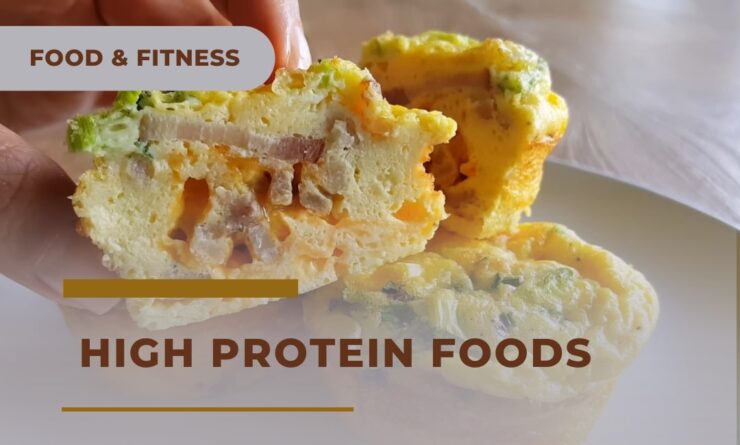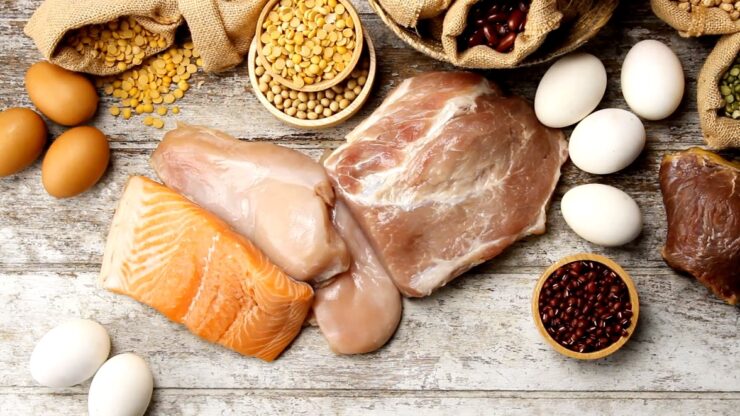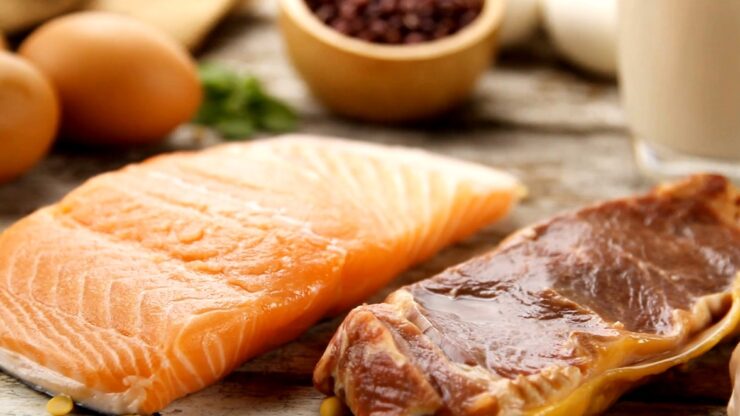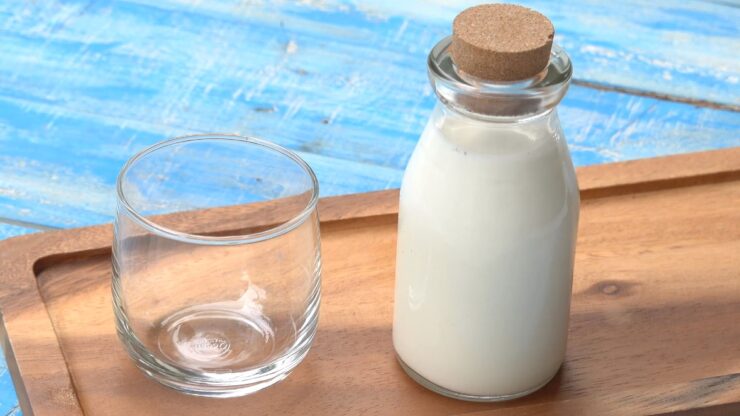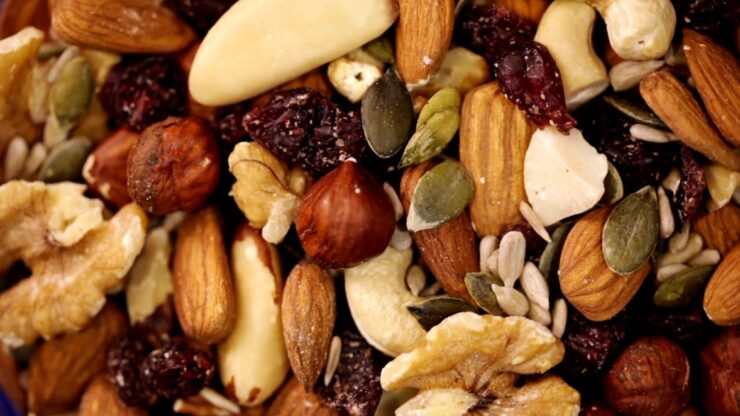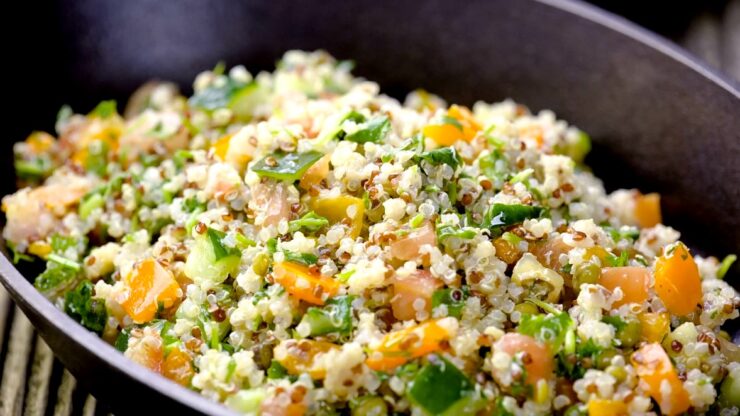High protein foods play a vital role in maintaining fitness and overall health. Incorporating these foods into your diet can help you stay energized and satisfied throughout the day. This article will introduce you to the concept of high protein foods and why they are crucial for staying fit.
The benefits of protein for the body will be explored, along with the recommended daily intake. Some of the top high protein foods, including lean meats, poultry, eggs, seafood, dairy products, legumes, nuts, seeds, tofu, and whole grains.
Tips on how to incorporate these foods into your diet will be provided, including meal prepping ideas and healthy snack options. The benefits of a high protein diet, for muscle building, metabolism boosting, appetite control, and improved bone health, will be discussed.
Considerations and potential risks related to protein quality, kidney health, and maintaining a balanced diet with nutrient variety will be addressed.
Key takeaway:
- High protein foods support staying: Including lean meats, poultry, eggs, seafood, dairy products, legumes, nuts, seeds, tofu, and whole grains in your diet can provide the necessary protein for maintaining energy levels and muscle health
- Protein benefits the body: Helps in building and repairing muscles, boosts metabolism and aids weight loss, controls appetite and reduces cravings, and improves bone health
- Considerations and potential risks: Pay attention to quality, digestibility, potential impact on kidney health, and maintain a balanced diet with nutrient variety
Why is Protein Important for Staying Fit?
Protein is crucial for staying fit because it plays a vital role in building and repairing tissues, regulating metabolism, supporting muscle growth, and providing energy. Without adequate protein, the body may not function optimally, which can have a negative impact on overall well-being and fitness goals.
- It is especially important for muscle recovery and repair. When engaging in physical activity and exercise, muscles are stressed and damaged, and protein helps in repairing and rebuilding them, resulting in stronger muscles. For individuals who regularly exercise, consuming enough is essential to support muscle growth and recovery.
- It has a significant impact on metabolism. It requires more energy to digest and metabolize compared to carbohydrates or fats. This is known as the thermic effect of food. By consuming protein-rich foods, metabolism is boosted, leading to increased calorie expenditure throughout the day. This can be beneficial for weight management and maintaining sustained energy levels.
- Helps in enhancing feelings of fullness and satiety. Including it in meals and snacks helps to control appetite and reduce cravings, making it easier to maintain a healthy eating pattern. This is particularly advantageous for managing weight and making healthier food choices.
Did you know that protein can also improve bone health? Adequate intake supports bone mineral density, reducing the risk of fractures, especially in older adults.
How Does Protein Benefit the Body?
Here, we will explore the various ways in which it benefits the body:
- Muscle growth and repair: crucial for building and repairing muscles. It aids in the repair of muscle tears and supports muscle growth, making it essential for athletes and those who want to increase their muscle mass.
- Enzyme and hormone production: necessary for the production of enzymes and hormones in the body. Enzymes facilitate chemical reactions, while hormones regulate bodily processes.
- Enhanced immune function: contributes to a strong and healthy immune system. Antibodies, which are proteins, help fight harmful bacteria, viruses, and pathogens. Adequate intake supports antibody production and boosts immune function.
- Regulation of satiety and weight management: increases feelings of fullness and reduces appetite, making it beneficial for weight management. By including protein-rich foods in your diet, you can control cravings, prevent overeating, and promote weight loss or maintenance.
- Tissue maintenance and repair: essential for maintaining and repairing tissues in the body, including the skin, hair, nails, and organs. It aids in the formation of new cells and promotes tissue regeneration, contributing to overall health.
- Promotion of healthy bones: necessary for collagen production, which provides structure and support to bones and connective tissues. Consuming adequate amounts helps maintain bone density, reducing the risk of conditions like osteoporosis and fractures.
How Much Do You Need?
When it comes to protein consumption, the amount you need depends on various factors such as age, sex, activity level, and overall health. So, how much do you need? Let’s break it down:
- Age: requirements vary across different life stages. Infants and young children require less compared to adolescents and adults.
- Sex: Men generally have higher needs due to differences in muscle mass and physiological factors.
- Activity Level: If you engage in regular physical activity or exercise, especially strength training or endurance activities, you will need more for muscle growth and repair.
- Health Goals: If your goal is to lose weight, incorporating protein in your diet can increase satiety and preserve muscle mass. The exact amount needed will depend on your calorie intake and specific diet plan.
For adults, it is recommended to consume a minimum of 0.8 grams of protein per kilogram of body weight. Athletes or individuals with higher activity levels may require up to 1.2-2 grams per kilogram.
To calculate your needs, simply multiply your weight in kilograms by the recommended protein intake range. For example, if you are a sedentary adult weighing 70 kilograms, you would need approximately 56-112 grams of protein per day (70 kg x 0.8 g/kg to 70 kg x 1.6 g/kg).
Remember, protein should always be part of a balanced diet that includes other essential nutrients. It is advisable to consult a healthcare professional or registered dietitian to determine your specific needs based on your individual circumstances and health goals.
Let’s look at John, a 40-year-old fitness enthusiast, who was concerned about a lack of muscle growth and strength despite regular exercise. Upon consulting a nutritionist, he was advised to increase his protein intake.
By diligently tracking his macronutrients and incorporating protein-rich foods such as lean meats and legumes into his diet, John experienced positive changes in his physique and energy levels. The increased protein intake helped him effectively build and repair his muscles, contributing to his fitness goals..
Top High Protein Foods
Looking to boost your protein intake for a healthier you? Well, look no further! In this section, we’ll explore the top high protein foods that will fuel your day with nutrients and keep you feeling satisfied.
1. Lean Meats
Lean meats are an excellent choice for individuals looking to maintain fitness and promote good health. Incorporating lean meats into your diet can provide you with a high-quality source of protein. Some examples of lean meats to include in your meals are:
- Chicken breast: This meat is low in fat and contains approximately 31 grams per 100 grams.
- Turkey breast: Another lean meat option, turkey breast offers about 29 grams oper 100 grams.
- Beef tenderloin: This particular cut of beef is low in fat and provides around 25 grams of 100 grams.
- Pork tenderloin: As a lean cut of pork, it offers approximately 22 grams per 100 grams.
- Veal: This lean meat option contains about 27 grams per 100 grams.
Including lean meats in your diet ensures that you receive essential nutrients and amino acids necessary for muscle development, metabolism enhancement, weight loss support, and overall well-being. Lean meats are rich in iron, zinc, and B vitamins.
When selecting lean meats, opt for cuts with minimal visible fat and remove the skin from poultry. Proper cooking techniques are also important to maintain the nutritional value and ensure food safety.
Incorporating lean meats into your meals can be as simple as grilling chicken breast or adding lean ground beef to a stir-fry. Experiment with different cooking methods and flavors to make your meals both enjoyable and nutritious.
Remember to balance your protein intake by including a variety of nutrient-rich foods in your diet, such as fruits, vegetables, whole grains, and legumes. A well-rounded and balanced diet is essential for a healthy and fit body.
The next time you plan your meals, consider including lean meats like chicken breast, turkey breast, beef tenderloin, pork tenderloin, or veal. These options not only provide delicious flavors but also offer a nutritious and beneficial way to maintain fitness and promote good health.
2. Eggs
Eggs are high protein foods rich in essential nutrients for overall health. Eggs provide around 6 grams of protein, along with vitamins and minerals like vitamin B12, vitamin D, and choline. They also contain healthy fats.
Incorporating eggs into your diet brings several benefits:
- Builds and repairs muscles: The high protein content of eggs supports muscle growth and repair, making them beneficial for exercise or strength training.
- Boosts metabolism and aids in weight loss: A higher thermic effect, requiring more energy to digest and metabolize, which aids in boosting metabolism and supporting weight loss.
- Controls appetite and reduces cravings: Increase feelings of fullness, helping control appetite and prevent overeating.
- Improves bone health: Eggs, with their vitamin D and calcium content are beneficial for improving bone health.
3. Seafood and Fish
ext up, seafood and fish are excellent choices. Not only do they provide protein, but they also offer a range of health benefits.
- Seafood and fish, such as salmon, tuna, cod, shrimp, sardines, and mackerel, are all rich sources of protein. Salmon contains 22g per 100g and is known for its high omega-3 fatty acid content, which promotes heart health and reduces inflammation.
- Tuna, on the other hand, provides 26g and is packed with essential amino acids that support muscle growth and repair.
- Cod is a lean white fish that offers 20g with low fat content.
- Shrimp is low in calories but high in protein, making it a great choice. It also provides selenium and other important minerals.
- Sardines are loaded with omega-3 fatty acids and vitamin D, which is beneficial for bone health.
- Mackerel is high in omega-3 fatty acids and also provides vitamin D and selenium.
Incorporating seafood and fish into your diet not only ensures a good protein intake but also provides essential nutrients like omega-3 fatty acids, vitamins, and minerals that are vital for overall health.
These nutrient-rich foods can improve heart health, support muscle growth and repair, and promote healthy bones. When buying seafood, it is advisable to choose wild-caught varieties whenever possible, as they tend to have higher levels of beneficial nutrients compared to farmed options.
4. Dairy Products
Dairy Products supply vital nutrients such as calcium, vitamin D, and potassium. To give you a better understanding of the protein content of various dairy products, refer to the table below:
| Dairy Product | Protein Content per 100g |
| Plain Greek Yogurt | 10g |
| Cottage Cheese | 11g |
| Mozzarella Cheese | 22g |
| Cheddar Cheese | 25g |
| Milk | 3.4g |
Pro-Tip: Opt for low-fat or reduced-fat options to avoid consuming excessive saturated fats. You can experiment with different dairy products to find the ones that suit your palate. You can try them in recipes like smoothies, salads, or even use them as toppings for whole grain cereals. Keep in mind your dietary preferences and any lactose intolerance or allergies when selecting your dairy products.
5. Legumes and Beans
Legumes and beans, such as lentils, chickpeas, black beans, kidney beans, and soybeans, are rich in protein and should be included as part of a well-balanced diet.
| Legume/Bean | Protein per 100g |
| Lentils | 9g |
| Chickpeas | 19g |
| Black Beans | 21g |
| Kidney Beans | 24g |
| Soybeans | 36g |
legumes and beans are low in fat and cholesterol, high in fiber, vitamins, and minerals, and serve as an excellent source of plant-based protein. This makes them an ideal choice for individuals following vegetarian or vegan diets.
Including legumes and beans in your meals is both versatile and simple. They can be used in various dishes such as soups, stews, salads, side dishes, pastas, and even as meat substitutes in burgers and patties.
It is important to be mindful of portion sizes when consuming legumes and beans. Although they are nutrient-dense, they also contain carbohydrates. Hence, it is crucial to maintain a balance in your overall macronutrient intake and consume a variety of foods to meet your nutritional needs.
To maximize the benefits, it is recommended to combine legumes and beans with other protein sources and whole grains. This will ensure a complete amino acid profile and provide for a well-rounded meal.
6. Nuts and Seeds
Nuts and seeds are rich sources of protein and essential nutrients. They can be enjoyed on their own or added to various dishes. Here is a table presenting the nutritional composition of some common nuts and seeds:
| Nuts and Seeds | Protein (per 100g) | Fat (per 100g) | Carbohydrates (per 100g) | Fiber (per 100g) |
| Almonds | 21g | 49g | 22g | 12g |
| Walnuts | 15g | 65g | 14g | 7g |
| Cashews | 18g | 44g | 30g | 3g |
| Pistachios | 20g | 45g | 28g | 10g |
| Chia seeds | 17g | 31g | 44g | 34g |
| Flaxseeds | 18g | 42g | 29g | 27g |
Nuts and seeds provide a good balance of protein, healthy fats, fiber, vitamins, minerals, antioxidants, and Omega-3 fatty acids. Including nuts and seeds in your diet offers numerous health benefits.
Incorporating a variety of nuts and seeds into your meals and snacks can enhance your protein intake. You can enjoy them in salads, stir-fries, yogurt, smoothies, or as a snack. It’s important to consume nuts and seeds in moderation as they are calorie-dense.
Individuals with nut allergies should avoid nuts and choose alternatives. If you have specific dietary restrictions or health conditions, consult a healthcare professional before making significant changes to your diet.
7. Tofu and Soy-based Products
Tofu and soy-based products are excellent high protein options. These plant-based sources offer various health benefits.
| Tofu | Soy Milk | Tempeh |
| Tofu is a versatile food made from soybeans. It is a complete protein, containing all essential amino acids. It is low in calories and high in nutrients like iron and calcium. | Soy milk is a popular dairy milk alternative made from soybeans. It is an excellent source of plant-based protein. It is often fortified with essential vitamins and minerals, making it a nutritious choice. | Tempeh is a fermented soy product that is high in protein and low in fat. It contains all essential amino acids and is a good source of iron. It also provides probiotics, which are beneficial for gut health. |
| Soy Yogurt | Edamame | Soy Sauce |
| Soy yogurt is a delicious dairy-free alternative to traditional yogurt. It is made from soy milk and contains live cultures that promote digestive health. It is also a good source of protein. | Edamame refers to young soybeans that are harvested before they mature. They are commonly consumed as a snack or added to salads and stir-fries. Edamame is packed with protein, fiber, and various vitamins and minerals. | Soy sauce is a condiment made from fermented soybeans. While it is not a significant source of protein, it adds flavor to dishes without many calories. It is important to choose low-sodium soy sauce. |
Incorporating tofu and soy-based products into your diet provides a wide range of nutrients and helps meet your needs. Whether you follow a vegetarian or vegan diet or simply want more plant-based protein in your meals, these options are worth considering.
It’s important to note that while tofu and soy-based products can be beneficial, choosing non-GMO and organic options whenever possible is essential. Individuals with soy allergies or certain medical conditions should consult a healthcare professional before incorporating these products into their diet.
8. Quinoa and Other Whole Grains
Quinoa and other whole grains are high protein foods that offer a range of nutritional benefits. Here is a table highlighting key information about these grains:
| Whole Grain | Protein Content per 100g | Other Nutritional Benefits |
| Quinoa | 14g | High in fiber, iron, magnesium, and antioxidants |
| Brown Rice | 7g | Contains fiber, vitamins, and minerals |
| Oats | 17g | Rich in fiber, vitamins, zinc, and folate |
| Barley | 12g | Good source of fiber, vitamins, and minerals |
| Buckwheat | 13g | High in fiber, antioxidants, and minerals |
These whole grains are excellent plant-based protein sources. In addition, they have unique traits:
- Quinoa is rich in fiber, iron, magnesium, and antioxidants.
- Brown rice provides fiber, vitamins, and minerals
- Oats are high in fiber, zinc, and folate.
- Barley offers fiber, vitamins, and minerals,
- Buckwheat is rich in fiber, antioxidants, and minerals.
You can incorporate quinoa and other whole grains into your diet in various ways. They can be prepared as a side dish, used as a base for salads, or substituted for rice or pasta in recipes. Brown rice, oats, barley, and buckwheat can be used in soup, stews, stir-fries, or as a side dish.
Including these whole grains in your diet can enhance your overall well-being. Their protein content aids in muscle building and repair, provides energy, supports weight management, and helps control appetite and reduce cravings. The fiber and other nutrients in these grains improve digestive health and promote satiety.
When incorporating quinoa and other whole grains into your diet, it’s important to remember they should be part of a balanced diet that includes a variety of nutrient-rich foods to ensure optimal health. If you have specific health conditions or dietary restrictions, consult with a healthcare professional or nutritionist for guidance.
How to Incorporate these Foods into Your Diet
From meal prepping ideas to healthy snack options, this section has you covered. Say goodbye to hunger pangs and hello to nourishing your body with the power of protein. Get ready to revitalize your meals and stay fit all day!
Meal Prepping Ideas
Looking for meal prepping ideas? Here are a few suggestions:
- Batch cooking: Make a large amount of lean meats like chicken or turkey, and divide them into portions that can be refrigerated or frozen. This makes it easy to incorporate into your meals throughout the week.
- Mason jar salads: Create layers of high protein ingredients like grilled chicken, chickpeas, and quinoa in a mason jar. This allows for a quick and protein-packed salad that you can grab and go.
- Protein smoothie packs: Portion your preferred powder into individual bags or containers, along with other ingredients like frozen berries, spinach, and almond milk. In the morning, blend everything together for a convenient high protein breakfast.
- Egg muffins: Beat eggs with vegetables, cheese, and cooked lean meats, then pour the mixture into muffin tins. Bake them for protein-rich egg muffins that can be enjoyed for breakfast or as a snack.
- Quinoa bowls: Cook a large amount of quinoa and portion it into individual containers. Add grilled chicken, roasted vegetables, and your favorite dressing for a satisfying and protein-packed meal.
Healthy High Protein Snack Options
When it comes to maintaining a healthy lifestyle, it is beneficial to incorporate healthy high protein snack options into your diet. These snacks provide energy and help keep you feeling full between meals. Here are some healthy snack options to consider:
- Greek Yogurt: With approximately 17 grams of protein per serving, Greek yogurt is also rich in calcium and probiotics, which are good for gut health.
- Hard-Boiled Eggs: convenient and protein-packed snack, providing about 6 grams of protein per egg. They are also a great source of essential vitamins and minerals.
- Protein Smoothie: By blending protein powder, almond milk, and fruits, you can create a protein smoothie that provides around 20 grams of protein, depending on the type of powder used.
- Edamame: As a plant-based snack, edamame is high in protein, offering approximately 17 grams of protein per cup. It is also a good source of fiber and other essential nutrients.
- Roasted Chickpeas: These crunchy snacks contain about 15 grams of protein per cup. They are a great source of fiber.
- Cottage Cheese: With approximately 14 grams of protein per half-cup, cottage cheese is a rich source of protein. It also provides calcium and other essential nutrients.
- Almonds: Almonds are a nutrient-dense snack that provides both protein and healthy fats. With about 6 grams of protein per ounce, they make a satisfying and portable option.
- Turkey Slices: Whether enjoyed on their own or wrapped around vegetables, turkey slices are a lean protein option. They provide around 7 grams of protein per ounce.
Fun fact: Incorporating protein-rich snacks into your post-workout routine can help enhance muscle recovery and growth. Including these healthy snacks in your post-workout routine contributes to better muscle repair, supporting your fitness journey.
Benefits of a High Protein Diet
Prepare to be amazed by the positive impact that a protein-rich diet can have on your overall fitness and well-being. Let’s explore the science-backed advantages that will keep you fueled and fit throughout the day!
1. Builds and Repairs Muscles
Building and repairing muscles requires consuming a variety of high protein foods. These foods serve as the necessary building blocks for muscle growth and recovery, making them crucial for athletes, fitness enthusiasts, and anyone looking to improve their strength and physique.
2. Boosts Metabolism and Supports Weight Loss
A high protein diet naturally boosts metabolism and supports weight loss. Here’s why:
- requires more energy to digest compared to carbs and fats, which increases your metabolic rate. This means that even at rest, you burn more calories.
- essential for preserving and building lean muscle mass. Since muscle burns more calories than fat, having more muscle can increase your metabolic rate and help with weight management.
- helps you feel fuller for a longer period of time, effectively controlling your appetite, reducing cravings, and preventing overeating. This makes it easier to maintain a calorie deficit for weight loss.
- stimulates the production of hormones that aid in the breakdown of body fat and promote fat oxidation.
- crucial for maintaining and repairing body tissues, including muscles. During weight loss, it is important to preserve muscle mass as it helps maintain your metabolism.
- effectively boost metabolism and support weight loss, it is recommended to include a variety of high protein foods in your diet. Here are some options:
3. Controls Appetite and Reduces Cravings
Controlling appetite and reducing cravings are essential for a healthy diet. Incorporating high protein foods into your meals can effectively control appetite and reduce cravings.
4. Improves Bone Health
Improving bone health is a key benefit of a high protein diet. Including protein-rich foods in your diet can improve bone health and prevent conditions like osteoporosis. Here are some reasons why a high protein diet improves bone health:
- Promotes calcium absorption: Sufficient intake helps improve the absorption of calcium, which is crucial for strong bones.
- Stimulates bone formation: plays a vital role in the production of collagen, which provides support for bone formation and repair.
- Enhances muscle strength: supports the growth and maintenance of muscles, which is essential for bone health.
- Boosts bone mineral density: Adequate intake enhances bone mineral density, reducing the risk of fractures.
To improve bone health, include the following protein-rich foods in your diet:
Considerations and Potential Risks
When it comes to high protein foods, there are important considerations and potential risks to keep in mind. We’ll dive into the protein quality and digestibility factors, the potential impact on kidney health, and the significance of maintaining a balanced diet and nutrient variety.
By understanding these aspects, you’ll be better equipped to make informed choices and stay fit throughout the day. So, let’s explore the crucial points and uncover the truth behind protein intake for optimal health.
1. Quality and Digestibility
It’s important to assess the quality and digestibility of the protein you consume. The table below outlines the protein quality and digestibility of common sources:
| Protein Source | Protein Quality | Digestibility |
| Lean Meats | High | High |
| Poultry and Eggs | High | High |
| Seafood and Fish | High | High |
| Dairy Products | High | High |
| Legumes and Beans | Moderate | Moderate |
| Nuts and Seeds | Moderate | Moderate |
| Tofu and Soy-based Products | Moderate | High |
| Quinoa and Other Whole Grains | Low | Medium |
Choose sources with high protein quality and digestibility. These sources provide amino acids, the building blocks of proteins, which are easily absorbed and utilized by the body. Lean meats, poultry, eggs, seafood, and fish are excellent choices as they have high quality and are easily digested. These sources also provide a complete set of essential amino acids that the body cannot produce itself.
Legumes, beans, nuts, seeds, and tofu are also good sources of protein, although their protein quality and digestibility may be slightly lower compared to animal-based sources. They still provide valuable nutrients and can be included in a balanced diet.
Conversely, quinoa and other whole grains have lower quality and digestibility. While they are still sources of protein, they may not provide the same complete amino acid profile as animal-based or even legume-based proteins.
When incorporating high protein foods into your diet, aim for a variety of protein sources to ensure you receive a wide range of essential amino acids. This supports muscle growth, repair, and overall health. Also, consider cooking methods that preserve the nutritional value of these protein sources, such as grilling, baking, or steaming, rather than deep-frying.
Pro-tip: Remember, it’s not just about protein quantity but also quality. Aim to include a variety of protein sources in your diet to ensure you obtain a complete amino acid profile.
2. Potential Impact on Kidney Health
It’s important to consider its potential impact on kidney health. The kidneys filter waste and maintain fluid balance in the body. Consuming excessive protein puts strain on the kidneys, making them work harder to eliminate waste. This can potentially lead to kidney damage over time.
Those with pre-existing kidney conditions are more at risk. The potential impact of protein on kidney health may vary based on age, overall health, and hydration. It’s important to balance intake with individual needs and consult a healthcare professional.
Moderate protein intake, within recommended guidelines, is generally safe for healthy individuals. Caution is needed for those with pre-existing kidney conditions.
To incorporate high protein foods into your diet, strike a balance and consider the potential impact on kidney health. Be mindful of individual needs, consult professionals, and maintain a balanced approach. Enjoy the benefits of a high protein diet while minimizing risks to kidney health.
3. Balanced Diet and Nutrient Variety
A balanced diet and nutrient variety are essential for maintaining good health. It is important to incorporate a wide range of fruits and vegetables into your meals.
When it comes to grains, opt for whole grains like quinoa, brown rice, and whole wheat bread as opposed to refined grains. Whole grains are rich in fiber and provide a steady release of energy, keeping you feeling full.
Add sources of unsaturated fats to your diet such as avocados, nuts, and olive oil, as these fats are crucial for brain health, nutrient absorption, and hormone production.
Including dairy or dairy alternatives is important for obtaining calcium and vitamin D. To minimize saturated fat intake, choose low-fat options. Legumes and beans are fantastic choices for plant-based proteins, fiber, vitamins, and minerals, making them ideal for vegetarians and vegans.
Remember to stay hydrated by drinking plenty of water. Water aids in digestion, regulates body temperature, and facilitates nutrient transportation. By following these suggestions and adjusting your food choices based on your individual needs and preferences, you can ensure a balanced diet and nutrient variety.
Key Facts:
- ✅ Essential for overall health and is found in foods such as eggs, nuts, lean meats, fish, dairy, and certain grains. (Source: Healthline)
- ✅ High-protein foods are important for a well-rounded, nutritious eating plan. (Source: Prevention)
- ✅ Help with building and repairing muscle tissue, as well as other essential functions in the body. (Source: Prevention)
- ✅Important for feeling satiated and can be found in various sources such as nuts, fish, dairy, legumes, and whole grains. (Source: EatingWell)
- ✅ It is recommended to distribute protein throughout the day and incorporate it into meals and snacks to remain fuller between meals and efficiently use the protein consumed. (Source: EatingWell)
FAQs
What are high protein foods and why are they important for staying fit all day?
High protein foods are versatile, easy to prepare, making them excellent choices for staying fit all day. Crucial for various aspects of our health, including immune system support, bone and skin health, hormone and enzyme production, and muscle-building.
In addition, protein is the most filling macronutrient, reducing hunger cravings and boosting metabolism. Eating more has also been linked to lower blood pressure, cholesterol, and the risk of osteoporosis and fractures.
Incorporating high protein foods into your diet can also reduce inflammation, regulate blood sugar levels, and lower the risk of heart disease.
How can high protein foods help with weight management?
High protein foods can be beneficial for weight management because it is the most filling macronutrient. It reduces hunger cravings and increases satiety, helping to keep you feeling full for longer periods of time.
In addition, protein boosts metabolism and prevents muscle breakdown during dieting, which can lead to more effective fat loss. By incorporating high protein foods into your meals and snacks, you can support your weight management goals and maintain a healthy, fit body.
How much should I consume daily to stay fit?
The recommended amount of protein intake varies based on individual goals, activity levels, and body mass. For general fitness, it is recommended to consume 0.8-1.0 grams of protein per kilogram of body weight per day.
Older individuals and athletes may benefit from higher protein intake. Recent research suggests that higher protein intake can be beneficial for muscle gain and fat loss. It is important to consult with a healthcare professional or registered dietitian to determine the appropriate protein intake for your specific needs.
Can high protein foods benefit mental health?
Yes, they can play a role in mood regulation and mental health. Protein is essential for the production of hormones and enzymes that are involved in brain function and mood regulation.
Protein helps support the structure of cells, including those in the brain, and provides the building blocks for neurotransmitters. By including these foods in your diet, you can support overall mental well-being and potentially reduce the risk of mental health disorders.
Are there any specific high protein snacks that can keep me feeling full longer?
Yes, there are several\ snacks that can help you stay full longer. Some examples include:
- DIY Trail Mix: A mix of almonds, pepitas, walnuts, dark chocolate chips, and dried apricots.
- Yogurt Parfait: Greek yogurt with fresh berries and sliced almonds.
- Veggies & Hummus: Celery and carrots with hummus.
- Hard-Boiled Eggs: Seasoned with salt, pepper, or hot sauce.
- Peanut Butter with Apple Slices: Apples dipped in peanut butter.
- String Cheese with Whole-Wheat Crackers: Low-fat string cheese paired with whole-wheat crackers.
- Cottage Cheese & Berries: Tangy cottage cheese topped with a variety of berries.
- Edamame: In-shell edamame seasoned with salt.
- Roasted Chickpeas: Roasted chickpeas seasoned with various spices.
- Smoothie: A blend of Greek-style yogurt, low-fat milk, frozen fruit, and almond butter.

